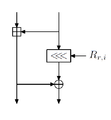Skein (hash function)
 | |
| General | |
|---|---|
| Designers | Bruce Schneier, Niels Ferguson |
| Derived from | Threefish |
| Certification | SHA-3 finalist |
| Detail | |
| Digest sizes | arbitrary |
| Rounds | 72 (256 & 512 block size), 80 (1024 block size) |
| Speed | 6.1 cpb on Core 2.[1] |
This article may be too technical for most readers to understand. (April 2013) |
Skein is a cryptographic hash function and one out of five finalists in the NIST hash function competition. Entered as a candidate to become the SHA-3 standard, the successor of SHA-1 and SHA-2, it ultimately lost to NIST hash candidate Keccak.[2]
The name Skein refers to how the Skein function intertwines the input, similar to a skein of yarn.[1]
History
Skein was created by Bruce Schneier, Stefan Lucks, Niels Ferguson, Doug Whiting, Mihir Bellare, Tadayoshi Kohno, Jon Callas and Jesse Walker.
Skein is based on the Threefish tweakable block cipher compressed using Unique Block Iteration (UBI) chaining mode while leveraging an optional low-overhead argument-system for flexibility.
Functionality
Skein supports internal state sizes of 256, 512 and 1024 bits, and arbitrary output sizes.[3]
The authors claim 6.1 cycles per byte for any output size on an Intel Core 2 Duo in 64-bit mode.[4]
The core of Threefish is based on a MIX function that transforms 2 64-bit words using a single addition, rotation by a constant and XOR. The UBI chaining mode combines an input chaining value with an arbitrary length input string and produces a fixed size output.
-
Threefish Mix Function
Threefish's nonlinearity comes entirely from the combination of addition operations and exclusive-ORs; it does not use S-boxes. The function is optimized for 64-bit processors, and the Skein paper defines optional features such as randomized hashing, parallelizable tree hashing, a stream cipher, personalization, and a key derivation function.
Cryptanalysis
In October 2010, an attack that combines rotational cryptanalysis with the rebound attack was published. The attack finds rotational collisions for 53 of 72 rounds in Threefish-256, and 57 of 72 rounds in Threefish-512. It also affects the Skein hash function.[5] This is a follow-up to the earlier attack published in February, which breaks 39 and 42 rounds respectively.[6]
The Skein team tweaked the key schedule constant for round 3 of the NIST hash function competition, to make this attack less effective, even though they believe the hash would be secure even without these tweaks.[1]
References
- ^ a b c Ferguson; et al. (2010-10-01). "The Skein Hash Function Family" (PDF).
{{cite journal}}: Cite journal requires|journal=(help); Explicit use of et al. in:|author=(help) - ^ "NIST Selects Winner of Secure Hash Algorithm (SHA-3) Competition". NIST. Retrieved 2012-10-02.
{{cite web}}:|first=has numeric name (help);|first=missing|last=(help) - ^ "Now From Bruce Schneier, the Skein Hash Function". Slashdot. Retrieved 2008-10-31.
{{cite web}}:|first=has numeric name (help);|first=missing|last=(help) - ^ Paper describing the hash function, Version 1.3 (2010-10-01)
- ^ Dmitry Khovratovich, Ivica Nikolic, Christian Rechberger (2010-10-20). "Rotational Rebound Attacks on Reduced Skein".
{{cite journal}}: Cite journal requires|journal=(help)CS1 maint: multiple names: authors list (link) - ^ Dmitry Khovratovich and Ivica Nikolić (2010). "Rotational Cryptanalysis of ARX" (PDF). University of Luxembourg.
{{cite journal}}: Cite journal requires|journal=(help)
External links
Implementations
- SPARKSkein - an implementation of Skein in SPARK, with proofs of type-safety
- Botan contains a C++ implementation of Skein-512
- nskein - A .NET implementation of Skein with support for all block sizes
- Skein module for Python
- Digest::Skein, an implementation in C and Perl
- A C# implementation of Skein and Threefish (based on version 1.3)
- Java, Scala, and Javascript implementations of Skein 512-512 (based on version 1.3)
- A Java implementation of Skein (based on version 1.1)
- An implementation of Skein in Ada
- Skein hash function for Erlang, via NIFs
- Skein 512-512 implemented in Bash
- Skein implemented in Haskell
- VHDL source code developed by the Cryptographic Engineering Research Group (CERG) at George Mason University
- Skein implemented in Ruby
- An efficient implementation of Skein-256 for 8-bit Atmel AVR microcontrollers, meeting the performance estimates outlined in the official specification

